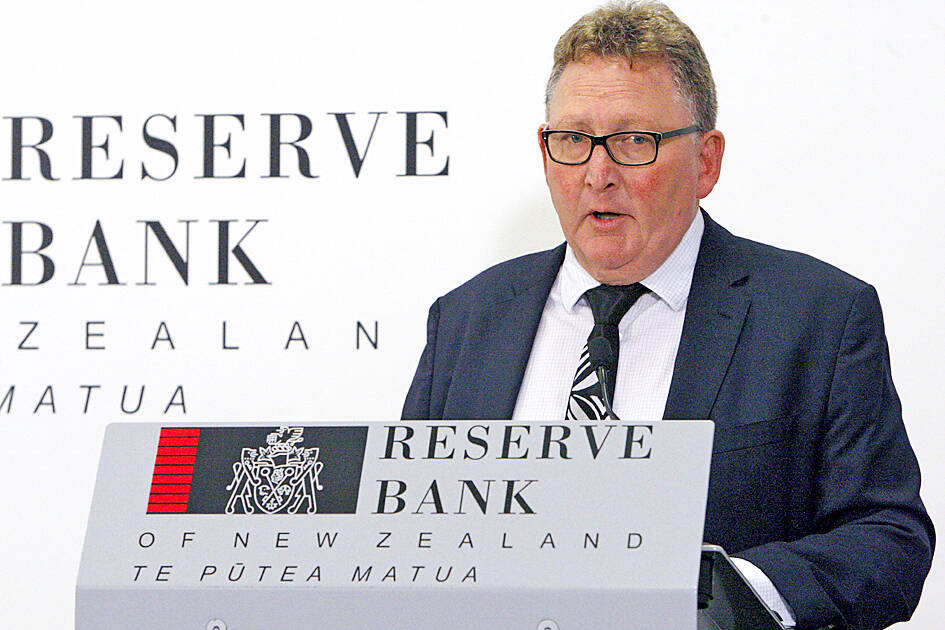New Zealand’s central bank yesterday raised interest rates by a quarter-percentage point and unexpectedly signaled that no further policy tightening would be needed to tame inflation, sending the nation’s currency tumbling.
The Reserve Bank of New Zealand’s (RBNZ) Monetary Policy Committee lifted the official cash rate (OCR) to 5.5 percent from 5.25 percent, as expected by 18 of 21 economists surveyed by Bloomberg.
The central bank’s forecasts show the OCR has now peaked, with cuts beginning in the third quarter of next year.

Photo: AP
The New Zealand dollar dropped as much as 1.3 percent to its lowest since May 2 as traders were surprised by the committee’s decision not to keep the door open to further tightening.
The currency bought US$0.6168 at 4:22pm in Wellington. The yield on policy-sensitive two-year bonds dropped the most in six months.
New Zealand has been in the vanguard of global tightening, with its 525 basis points of rate hikes outpacing even the US Federal Reserve.
The RBNZ has been trying to rein in a sharp burst of inflation and yesterday’s decision suggests it is now relying on the lagged impact of higher borrowing costs to keep cooling consumer prices.
“The real surprise for the market was the RBNZ effectively declaring ‘mission accomplished’ on rate hikes,” said Prashant Newnaha, senior Asia-Pacific rates strategist at TD Securities in Singapore. “Quite clearly this is a board that is content moving to the sidelines, letting prior rate hikes and expectations of the economy entering recession to naturally drive inflation down.”
Still, the bank’s forecasts show a shallower economic slowdown, with only a mild recession projected for the second and third quarters of this year.
“The committee is confident that with interest rates remaining at a restrictive level for some time, consumer price inflation will return to within its target range of 1-3 percent per annum,” the RBNZ said. “Inflation is expected to continue to decline from its peak and with it measures of inflation expectations.”
Inflation slowed to 6.7 percent in the first quarter and the central bank predicts it would return to its target band by the third quarter of next year.
Most economists expected it to keep the door open for a further rate increase if needed, arguing that surging immigration and looser fiscal policy would add to price pressures.
By contrast, the committee’s record of the meeting showed members discussed the option of keeping rates unchanged and voted 5-2 in favor of a hike.

The US dollar was trading at NT$29.7 at 10am today on the Taipei Foreign Exchange, as the New Taiwan dollar gained NT$1.364 from the previous close last week. The NT dollar continued to rise today, after surging 3.07 percent on Friday. After opening at NT$30.91, the NT dollar gained more than NT$1 in just 15 minutes, briefly passing the NT$30 mark. Before the US Department of the Treasury's semi-annual currency report came out, expectations that the NT dollar would keep rising were already building. The NT dollar on Friday closed at NT$31.064, up by NT$0.953 — a 3.07 percent single-day gain. Today,

‘SHORT TERM’: The local currency would likely remain strong in the near term, driven by anticipated US trade pressure, capital inflows and expectations of a US Fed rate cut The US dollar is expected to fall below NT$30 in the near term, as traders anticipate increased pressure from Washington for Taiwan to allow the New Taiwan dollar to appreciate, Cathay United Bank (國泰世華銀行) chief economist Lin Chi-chao (林啟超) said. Following a sharp drop in the greenback against the NT dollar on Friday, Lin told the Central News Agency that the local currency is likely to remain strong in the short term, driven in part by market psychology surrounding anticipated US policy pressure. On Friday, the US dollar fell NT$0.953, or 3.07 percent, closing at NT$31.064 — its lowest level since Jan.

Hong Kong authorities ramped up sales of the local dollar as the greenback’s slide threatened the foreign-exchange peg. The Hong Kong Monetary Authority (HKMA) sold a record HK$60.5 billion (US$7.8 billion) of the city’s currency, according to an alert sent on its Bloomberg page yesterday in Asia, after it tested the upper end of its trading band. That added to the HK$56.1 billion of sales versus the greenback since Friday. The rapid intervention signals efforts from the city’s authorities to limit the local currency’s moves within its HK$7.75 to HK$7.85 per US dollar trading band. Heavy sales of the local dollar by

The Financial Supervisory Commission (FSC) yesterday met with some of the nation’s largest insurance companies as a skyrocketing New Taiwan dollar piles pressure on their hundreds of billions of dollars in US bond investments. The commission has asked some life insurance firms, among the biggest Asian holders of US debt, to discuss how the rapidly strengthening NT dollar has impacted their operations, people familiar with the matter said. The meeting took place as the NT dollar jumped as much as 5 percent yesterday, its biggest intraday gain in more than three decades. The local currency surged as exporters rushed to